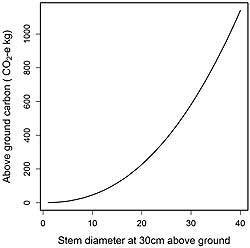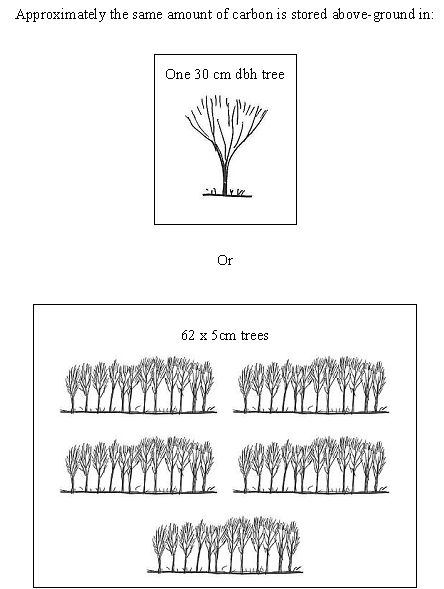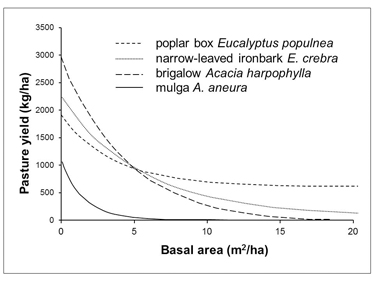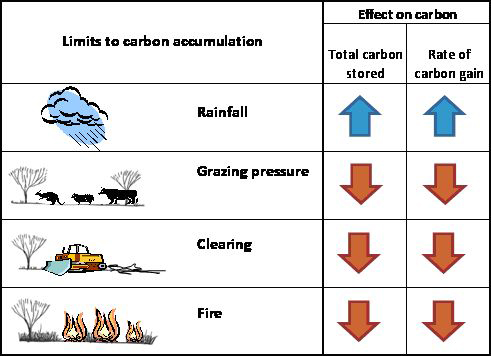Farming carbon

- Above-ground carbon in mulga vegetation is stored in living trees and shrubs, but also in dead standing trees, fallen timber and litter.
- The maximum amount of carbon stored by mature mulga increases with average annual rainfall.
- The above ground parts of woody plants in mulga vegetation could store about 30 to 150 tonnes of carbon dioxide equivalent per hectare, at a site with 400mm average annual rainfall.
- The peak carbon accumulation rate for mulga sites with average annual rainfall above 400mm is 1 to 2 tonnes or carbon dioxide equivalent per hectare per year.
- Rates of carbon accumulation above ground in regrowing mulga will be greatest in young forests with relatively high rainfall.
Carbon farming might not always mean bringing mulga vegetation back to its full carbon capacity as soon as possible.
Some carbon returns might be traded-off against other land-uses, such as livestock grazing, which may limit carbon accumulation rates.
Low to moderate levels of livestock grazing appear to be compatible with reforestation in mulga vegetation.
Note: to generate carbon credits you will need to register a project with the Clean Energy Regulator using an approved method. The methods detail the conditions or rules for generating carbon credits (Australian Carbon Credit Units) and how vegetation is to be managed as part of a project.
Carbon storage and tree size

| Tree dbh (cm) | Dry matter (kg) | Carbon (kg) | CO2 equivalent (kg) |
|---|---|---|---|
| 5 | 8 | 4 | 15 |
| 30 | 530 | 249 | 913 |

The approximate above-ground dry matter, carbon and carbon dioxide (CO2) equivalent stored in mulga trees of different diameters. Dbh = stem diameter measured at 1.3m height. (Allometry from Burrrows et al. cited in Eamus et al. 2000).
Large trees hold far more carbon than small ones, as the amount of carbon held increases exponentially with the trunk diameter. For example, the carbon held in an average large tree (e.g. approximately 30cm stem diameter) is about the same as that held in 62 smaller trees (e.g. 5cm stem diameters).
Trade-offs between trees and pasture
Increasing the basal area of trees tends to result in decreased pasture yield. This has been observed for a variety of vegetation types in Queensland, including mulga.
It should be possible to combine carbon farming of regrowth with livestock production, but landholders should consider how increased tree growth may impact on their pasture yield.
Retaining blocks or strips of trees within a paddock may provide opportunities to increase carbon storage while minimising the impact on pasture growth. Tree strips may provide some advantages by acting as a windbreak, which may help the growth of pasture beyond the competitive reach of tree roots.

Grow big trees to maximise carbon
A few big trees can hold far more carbon than a large number of small or medium trees. So it is in the interests of carbon farming to maximise the height and diameter of existing trees, which may be achieved by reducing tree density in dense regrowth. This may involve the selective thinning of smaller trees, or allowing drought and competition among trees to result in natural rates of tree dieback and thinning.
Increasing tree basal area is still likely to reduce pasture yield, but a few large trees will hold far more carbon than many small ones, for the same basal area.
Potential variations in tree size, density and CO2 equivalent stored for the same basal area. A high density of small trees (a) stores less CO2 equivalent than a lower density of larger trees (b).
| Tree dbh (cm) | Number of trees | Basal area (m2) | CO2 equivalent (kg) | |
|---|---|---|---|---|
| a) | 5 | 1528 | 3 | 22,918 |
| b) | 30 | 42 | 3 | 38,749 |

Limits to carbon accumulation
Carbon accumulation in mulga vegetation is limited by rainfall, grazing pressure, clearing and fire.
The total amount of carbon stored by mulga, and the rate it accumulates, can be maximised by removing these limits where possible.
Rainfall
Increased rainfall encourages plant growth and increases carbon accumulation if other limiting factors are managed.
Drought can kill both young and mature mulga trees.
Grazing pressure
Levels of grazing pressure that remove native grasses, shrubs and small trees, and prevent the recruitment of trees and shrubs will reduce the rate of carbon gain, decrease the capacity of vegetation to store carbon and produce a net carbon loss.
Clearing
Clearing mulga, including fodder harvesting, reduces the rate of carbon gain, decreases the capacity of the vegetation to store carbon, and results in a net carbon loss.
Fire
Large and intense fires result in a net carbon loss by consuming the carbon stored in trees, shrubs, dead wood and litter.
Repeated small fires reduce the rate of carbon gain by removing small trees and shrubs, and decrease the capacity of vegetation to store carbon by limiting the recruitment of mulga and other fire-sensitive species.


